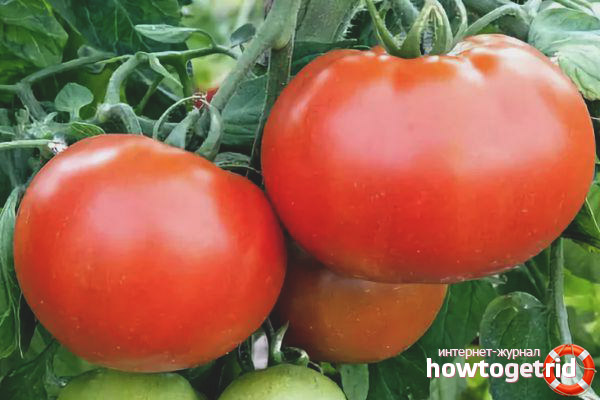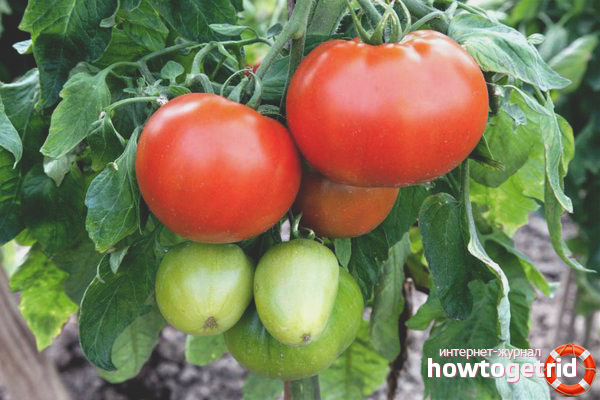The content of the article
Tomatoes are very popular among gardeners and farmers. A healthy and nutritious vegetable crop has a universal purpose, and is distinguished by many different varieties. Each species is attractive with certain individual properties. Tomato Weight Champion was bred by Russian breeders. The variety belongs to the first generation hybrids, is perfect for growing on beds and in closed ground. Gardeners appreciate the variety for its resistance to disease and its unpretentiousness to climatic conditions.
Grade description
- The variety has a mid-early ripening period.
- The bushes are strong and powerful, reaching a height of 2 meters.
- From one bush you can collect 6-7 kg of ripe fruit.
- The shape of the fruit is round, slightly flattened, ribbed sides.
- When ripening, they acquire a saturated red color.
- The pulp is dense and juicy.
- With a horizontal section, you can see 4-5 nests with seeds.
- The average weight of one tomato is 450 grams.
- Under favorable growing conditions, some fruits can weigh up to 1 kg.
- The taste of tomatoes is sweet. You can make sauces, pasta or juice, suitable for raw consumption.
Growing rules
The seeds are laid to a depth of 2-3 cm. Watering the crops is not necessary, it is enough to spray with water, cover with polyethylene or film from above. Before seedlings appear, the boxes must be indoors at a temperature of + 23- + 25 degrees. As soon as loops of sprouts appear on the surface, the shelter is removed.
Diving is carried out at the phase of the appearance of 1-2 leaves. Sprouts are planted in a separate container. About 10-14 days before planting in the soil, seedlings undergo hardening. To do this, the seedlings are taken out to the street every day, increasing the time spent. If tomatoes are grown in a greenhouse, then planting is carried out in May, for open ground planting is carried out in early July. Between seedlings should be a distance of 50 cm, row spacing - 70 cm.
Grade Care

Seedlings should be planted in a sunny area. Bushes form in 1 stalk. Near each hole, you need to install a support to which tall shoots will be tied. Stepsons need to be cut off in a timely manner. If the land for planting has not been fertilized since the fall, then 10 days after planting seedlings, it is necessary to make complex additives.
During the summer season, supplements containing phosphorus and potassium should be added. Fruiting lasts until the month of September. It is recommended to carry out plentiful watering once a week with warm, settled water. The procedure should be carried out after sunset. It is also imperative to loosen the soil and weed it.
To prevent the occurrence of the disease or from the invasion of insects, you can spray the bushes with insecticides.
Diseases and Pests
Powdery mildew is the most common disease in the nightshade family. This fungus most often affects plants that are grown indoors. Affected leaves contain a white coating. If signs of damage have become noticeable, then the affected leaves should be cut off and treatment with special preparations should be carried out. There may also be signs of infection with bacteriosis and anthracnosis.
Slugs feed not only on the foliage of the plants, but also on the fruits themselves. In order to scare them away, you need to sprinkle bushes with shag, egg shells. It is also recommended to place beer dishes next to the bushes. The smell of beer will attract slugs and they will fall into the trap.
Loosening and removing weeds will create a balance in the roots of the plants, and mulching the soil will help inhibit the growth of weed grass and the spread of fungal infections. Observing the rules for care, and conducting preventive measures, you can achieve good yields of varieties. Fresh fruits will be present in the diet until late autumn.
Video: how often and how much to water tomatoes?










Submit